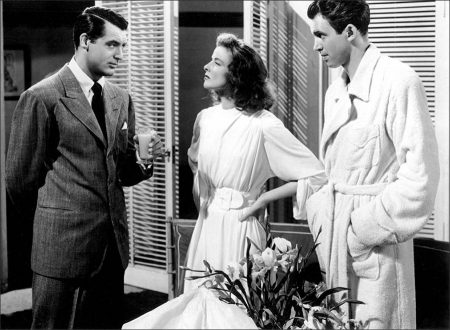Tagline: Broadway’s howling year-run comedy hit of the snooty society beauty who slipped and fell – IN LOVE!
The Philadelphia Story movie storyline. Philadelphia socialites Tracy Lord and C.K. Dexter Haven married impulsively, with their marriage and subsequent divorce being equally passionate. They broke up when Dexter’s drinking became excessive, it a mechanism to cope with Tracy’s unforgiving manner to the imperfect, imperfections which Dexter admits he readily has. Two years after their break-up, Tracy is about to remarry, the ceremony to take place at the Lord mansion.
Tracy’s bridegroom is nouveau riche businessman and aspiring politician George Kittredge, who is otherwise a rather ordinary man and who idolizes Tracy. The day before the wedding, three unexpected guests show up at the Lord mansion: Macaulay Connor (Mike to his friends), Elizabeth Imbrie – the two who are friends of Tracy’s absent brother, Junius- and Dexter himself. Dexter, an employee of the tabloid Spy magazine, made a deal with its publisher and editor Sidney Kidd to get a story on Tracy’s wedding – the wedding of the year – in return for Kidd not publishing a salacious story with accompanying photographs of Tracy’s father, Seth Lord, with a New York showgirl named Tina Marra.
In reality, Mike and Liz are the reporter and photographer respectively for Spy. Mike and Liz don’t particularly like this assignment or working for Kidd, but they need to make a living as their chosen other fields as serious writer and painter don’t pay the bills. A suspicious Tracy is onto them, the entire truth which Dexter admits to her. Tracy decides to turn the tables on Mike and Liz. However, hours before the wedding, as the more self-assured Dexter and Liz get to work on how to get the Lords out from under Spy’s threats, Tracy and Mike, both inebriated, go on a journey of self-discovery with Tracy ultimately coming to her realizations a little faster than Mike.
The Philadelphia Story (1940) is an intelligent, sophisticated, classic romantic comedy-farce (part screwball) of love and marriage, human growth and class distinctions. Its screenplay is a witty, sparkling, and bright adaptation of Philip Barry’s Broadway hit play. (The play opened in late March 1939 and ran for a full year with more than 400 performances and a nationwide tour). [Barry’s inspiration for the lead female character was derived from real-life Philadelphian WASP heiress Hope Montgomery Scott (1905-1995).] Barry, who is uncredited as the screenwriter in the film, wrote the part specifically for the talents of Katharine Hepburn who played the hit role in the theatre. [Hepburn’s suggested title for the play was The Answer to This Malden’s Prayer.]
After several commercial failures and labeled “box office poison” in 1938 by Photoplay Magazine, Hepburn struck out on her own by bringing the property to MGM after buying the film rights to the play. With producer Joseph L. Mankiewicz (for MGM), she was able to handpick the cast’s co-stars (James Stewart and Cary Grant), screenwriter (Donald Ogden Stewart, who later won the Academy Award), and director (George Cukor). Cukor had already made four films with Hepburn.
The Philadelphia Story (1940)
Directed by: George Cukor
Starring: Cary Grant, Katharine Hepburn, James Stewart, Ruth Hussey, John Howard, Roland Young, John Halliday, Mary Nash, Virginia Weidler, Henry Daniell, Lionel Pape, Rex Evans
Screenplay by: Donald Ogden Stewart
Production Design by:
Cinematography by: Joseph Ruttenberg
Film Editing by: Frank Sullivan
Costume Design by: Adrian
Set Decoration by: Edwin B. Willis
Art Direction by: Cedric Gibbons
Music by: Franz Waxman
Distributed by: Metro-Goldwyn-Mayer
Release Date: December 26, 1940
Views: 187

